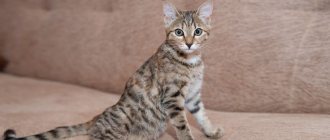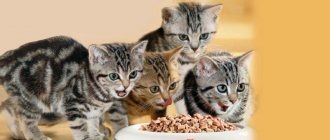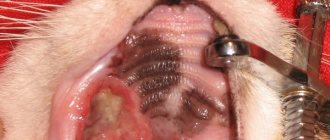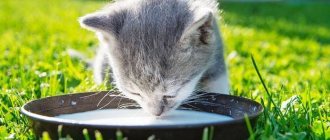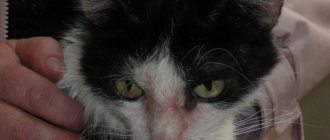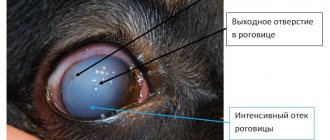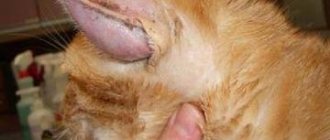4129Pavel
In most cats and cats, bilateral inflammation develops, which is not localized, but covers the entire thoracic region. Lack of timely monitoring can lead to death. With pleurisy, the pulmonary region and heart are at risk, and these are vital systems of the pet’s body.
In case of illness, the pleural surface is filled with moisture. In a normal healthy state, the pleura in the chest also releases moisture, but this amount is enough for “basic” processes to occur. When the fluid volume is exceeded, the pressure on the organs increases. If treatment is not organized, pathologies with the lungs and heart cannot be avoided.
© shutterstock
Types of disease
In veterinary medicine, it is customary to divide pleurisy into the following classes:
- By origin. Primary pleurisy - the serous membrane itself directly enters the affected area, since the inflammatory process begins precisely in its tissues. The secondary form, on the contrary, occurs against the background of some other ailments that affect neighboring organs and spread to the pleura. This includes malignant tumors that can metastasize, as well as any lung pathologies.
- According to the course, chronic, acute and subacute forms of pleurisy are distinguished. Each of them differs in the speed of the disease process. So acute lasts two weeks, subacute - 1-2 months, and chronic sometimes lasts for several years.
- Based on localization, doctors differentiate pleurisy into local and diffuse forms. In the first case, we are talking about the dislocation of inflammation in one place, and in the second, about its scattering throughout the serous membrane. Veterinarians also divide pleurisy into unilateral, in which the right or left side of the chest is affected, and bilateral, when the inflammatory process affects both sides.
- According to the nature of the inflammatory process, pleurisy can be exudative, when purulent effusion is actively released into the pleural cavity, and dry, in which the exudate mainly consists of protein fibrinogen. It folds easily and does not settle on the surface of the serous membrane, which is why effusion fluids do not accumulate in the pleural cavity.
Diagnosis and treatment of pleurisy
Diagnosis of pleurisy includes a set of examinations - a clinical examination using tapping and listening methods. As a rule, if pleurisy is suspected, an animal undergoes X-ray and ultrasound examination of the chest area.
When the suspected diagnosis is confirmed, the veterinarian prescribes a general blood and urine test. This is necessary to specify and identify the main cause that caused the onset of pleurisy. It is possible to perform a puncture of the pleural cavity to collect purulent exudate and further study it.
The animal must be treated immediately as soon as the diagnosis is confirmed. Any delay can cost your pet's life. In the vast majority of cases, pleurisy occurs against the background of a bacterial infection. Potent broad-spectrum antibiotics are used to treat and eliminate the source of inflammation.
Symptomatic therapy includes the use of:
- painkillers;
- antipyretics;
- diuretic medications (allows you to relieve swelling);
- multivitamin complexes and immunostimulants (increase the body’s own resistance to fight the disease).
If there is a strong accumulation of purulent effusion in the area of the pleural membrane, surgical drainage is performed. This is carried out using a special needle, which is inserted into the affected part to pump out the exudate. The cleaned pleural cavity is washed using special antiseptic preparations.
Causes of the disease
The appearance of a focus of inflammation on the pleura can be caused by many different reasons, the most common of which include:
- various pathogens of diseases in cats, namely worms, harmful bacteria, viruses, fungi and protozoa;
- consequences of inflammation occurring in the immediate vicinity of the serous membrane. This is especially true for lung diseases such as pneumonia or abscess;
- oncological pathologies, for example, lymphosarcoma or mesothelioma. They often lead to such a terrible disease as metastatic pleurisy, which is extremely difficult to treat, due to the fact that the pet’s body is already weakened by a malignant tumor;
- hypoalbuminemia, that is, a low amount of protein in the blood fluid, which is caused by problems with the liver and gastrointestinal tract;
- mechanical damage to the chest resulting from trauma;
- when drugs such as Furadonin or its closest analogues are used to treat a cat, without the supervision of a specialist;
- with a hernia of the diaphragm;
- the presence of a blood clot in the cat’s lungs, which prevents normal blood supply to this organ;
- blood (hemothorax) or lymph (chylothorax) entering the pet's chest;
- for pancreatitis and renal failure.
Owners should also pay attention to the fact that the cause of cat pleurisy may well be prolonged stress, vitamin deficiency, poor diet, overwork, and hypothermia.
How to suspect pleural effusion?
Signs of the presence of pleural effusion are inspiratory dyspnea - rapid breathing with difficulty exhaling and rapid heartbeat - tachycardia. There may also be signs of cardiac and respiratory failure - cyanosis of the mucous membranes of the oral cavity and tongue. If these symptoms are present, it is imperative to examine the animal to confirm the presence or absence of pleural effusion and to determine the reasons that provoked it.
Since the accumulation of fluid in the chest cavity causes compression of vital organs such as the heart and lungs, it is necessary to remove this fluid as quickly as possible. The amount and nature of the fluid may vary, which determines the severity of symptoms.
In our clinic, there were cases when it was necessary to remove 150-180 ml of fluid from the right and left halves of the chest cavity, respectively, and in total it reached 350 ml. In such conditions, due to strong compression, the work of the animal’s heart and lungs is significantly hampered, creating a life-threatening situation.
Symptoms of the disease
The symptoms of the pathology depend entirely on the form of the pathology. The differences are especially pronounced depending on whether exudate accumulates in the pleural cavity. The most typical general symptoms include:
- rapid breathing of the animal, as well as superficial respiratory movements;
- the pet’s apathy, its reluctance to get up from its favorite place again;
- decreased or complete lack of appetite;
- if the disease is expressed in a unilateral form, then the cat’s breathing becomes asymmetrical, since the affected side lags behind when inhaling and exhaling;
- If the owner puts his ear to the cat's chest, he can hear a characteristic noise (leaves of the serous membrane rubbing against each other).
To determine dry pleurisy, there are a number of signs, which include the pet being forced to lie on the side where the pathological process takes place, since arching in the opposite direction causes suffering to the cat. Breathing causes pain to the animal; the cat tries to attract the owner’s attention with a plaintive meow.
If purulent effusion accumulates abundantly in the pleural cavity, the cat’s condition quickly deteriorates. The pet's mucous membranes turn blue, blood pressure decreases, its urine takes on a dark tint and emits an unpleasant odor. In addition, the furry fidget suffers from severe shortness of breath and cough with a small amount of sputum. If pleurisy has affected both sides of the chest, then the only position in which the cat is able to breathe fully is sitting and with its head stretched forward.
Exudative pleurisy in cats is an extremely dangerous disease; if the animal is not provided with qualified therapy in the very near future, it will die. It is possible to remove fluid from the pleural cavity only in a veterinary clinic; it is impossible to do this at home.
Pleural fluid examination
To evacuate pleural fluid, as well as to obtain samples for laboratory testing, thoracentesis is used - a puncture of the chest. The method is low-traumatic, in most cases does not require sedation (sedation must be resorted to in case of increased excitability or aggressiveness of the animal).
Laboratory diagnosis of pleural fluid is necessary to make a diagnosis and determine the extent of the pathological process. Laboratory analysis describes the cellular, biochemical composition, physical characteristics of the liquid being tested, determines the type of exudate, the presence or absence of tumor cells.
If necessary, bacteriological (including to determine the sensitivity of identified bacteria to antibiotics) and virological studies (to identify antigens of viral peritonitis and feline viral leukemia) are carried out.
Thus, pleural effusion is always a consequence of very serious diseases. Therefore, if you notice that your cat is breathing heavily, you should contact your veterinarian. You will be asked to undergo an X-ray or ultrasound examination. If this results in the presence of free fluid in the chest cavity, it is necessary to:
- Perform thoracentesis, which will alleviate the animal’s condition (significantly reduce compression on the lungs and heart) and collect fluid for analysis.
- Take blood, urine, and stool tests. Based on the results of the blood test, a conclusion will be drawn about the presence and degree of the inflammatory process in the body, the amount of protein, albumin in the blood, and the presence of liver and kidney failure. By analyzing urine and feces, you can determine whether there are pathologies of the kidneys and intestines with protein loss.
- Conduct research for coronavirus infection, viral leukemia, respiratory infections of cats.
- Carry out symptomatic treatment prescribed by your doctor. The main treatment will be prescribed after receiving all the test results and making a reliable diagnosis, but even before the final diagnosis is made, it is necessary to begin symptomatic treatment that will alleviate your pet’s condition.
Chief veterinarian Elena Anatolyevna Rodionova
01/15/2014 / For owners
Treatment of the disease
Full treatment can be started only after establishing the nature of the disease and the reasons that caused the inflammatory processes. For this purpose, the doctor examines the cat using X-rays or ultrasound, and analyzes its blood fluid and urine. In case of a disease aggravated by pleural effusion, fluid is taken from the serous cavity, after which it is sent for examination to the laboratory, where they can accurately determine which microorganisms caused the pathology.
To treat pleurisy, antibiotics are used that can suppress the harmful effects of pathogenic microflora, as well as analgesics that dull the painful sensations experienced by the cat. If the doctor determines that the mustachioed friend is suffering from a high fever, then he is prescribed aspirin tablets. In addition, the doctor prescribes diuretics and multivitamins. The choice of pharmaceuticals is determined by the symptoms that accompany the disease.
The accumulation of exudate in the pleural cavity is eliminated by the drainage procedure, that is, pumping out fluid from there. After which the cavity is washed with antiseptics. It is important to understand that after all medical manipulations the animal will be weakened. In the next 1-2 weeks he will need complete rest and a balanced diet rich in vitamins and microelements.
Diagnostic measures
Only a specialist in a veterinary clinic can make an accurate diagnosis. If you notice these symptoms, immediately take your pet to a medical facility for examination and appropriate examination. The doctor will question the owner in detail about the onset of this disease and listen to the animal’s breathing through a phonendoscope.
Afterwards, the cat will need to undergo the following examinations: x-ray and ultrasound of the chest, general and biochemical blood tests; puncture of the sternum and laboratory testing of the resulting effusion.
Preventive actions
It is possible to prevent the development of pathology, the main thing is to avoid hypothermia of the pet. You cannot take your animal outside during the cold season and it is not recommended to bathe it. The owner must carefully monitor the diet: products must contain a large amount of protein; vitamin and mineral supplements can be used as complementary foods.
For preventive purposes, the owner is obliged to bring the cat annually for a routine examination. Monitor your pet to ensure that it does not suffer a chest injury. The healthiest foods to give to an animal are: legumes, fish, lean beef. It is necessary to exclude fatty pork, salty and fried foods from the diet.
